Construction of Single-Atom Catalysts for N, O Synergistic Coordination and Application to Electrocatalytic O2 Reduction
Abstract
:1. Introduction
2. Results and Discussion
2.1. The Structural Features of TM-N2O2Cx Single-Atom Catalysts
2.2. The Structural Stability of TM-N2O2Cx
2.3. O2 Adsorption
2.4. ORR Catalytic Performance
2.4.1. Selectivity of Reaction (2e− or 4e−)
2.4.2. 4e− Pathway
2.5. Scaling Relationship between Oxygen-Containing Intermediates
3. Computational Methods
4. Conclusions
Supplementary Materials
Author Contributions
Funding
Institutional Review Board Statement
Informed Consent Statement
Data Availability Statement
Acknowledgments
Conflicts of Interest
Sample Availability
References
- Ong, S.; Al-Othman, A.; Tawalbeh, M. Emerging technologies in prognostics for fuel cells including direct hydrocarbon fuel cells. Energy 2023, 277, 127721. [Google Scholar] [CrossRef]
- Stephens, I.E.L.; Rossmeisl, J.; Chorkendorff, I. Toward sustainable fuel cells. Science 2016, 354, 1378–1379. [Google Scholar] [CrossRef]
- Allendorf, M.D. Oxygen reduction reaction: A framework for success. Nat. Energy 2016, 1, 16058. [Google Scholar] [CrossRef]
- Wang, Y.; Li, J.; Wei, Z. Transition-metal-oxide-based catalysts for the oxygen reduction reaction. J. Mater. Chem. A 2018, 6, 8194–8209. [Google Scholar] [CrossRef]
- Chen, S.; Zhao, J.; Su, H.; Li, H.; Wang, H.; Hu, Z.; Bao, J.; Zeng, J. Pd-Pt Tesseracts for the Oxygen Reduction Reaction. J. Am. Chem. Soc. 2021, 143, 496–503. [Google Scholar] [CrossRef]
- Cui, P.; Zhao, L.; Long, Y.; Dai, L.; Hu, C. Carbon-Based Electrocatalysts for Acidic Oxygen Reduction Reaction. Angew. Chem. Int. Ed. 2023, 62, e202218269. [Google Scholar] [CrossRef]
- Tian, X.L.; Xu, Y.Y.; Zhang, W.; Wu, T.; Xia, B.Y.; Wang, X. Unsupported Platinum-Based Electrocatalysts for Oxygen Reduction Reaction. ACS Energy Lett. 2017, 2, 2035–2043. [Google Scholar] [CrossRef]
- Shao, M.; Chang, Q.; Dodelet, J.-P.; Chenitz, R. Recent Advances in Electrocatalysts for Oxygen Reduction Reaction. Chem. Rev. 2016, 116, 3594–3657. [Google Scholar] [CrossRef]
- Gawande, M.B.; Ariga, K.; Yamauchi, Y. Single-Atom Catalysts. Small 2021, 17, 2101584. [Google Scholar] [CrossRef]
- Su, J.; Zhuang, L.; Zhang, S.; Liu, Q.; Zhang, L.; Hu, G. Single atom catalyst for electrocatalysis. Chin. Chem. Lett. 2021, 32, 2947–2962. [Google Scholar] [CrossRef]
- Zhang, Q.; Guan, J. Single-Atom Catalysts for Electrocatalytic Applications. Adv. Funct. Mater. 2020, 30, 2000768. [Google Scholar] [CrossRef]
- Lin, L.; Chen, Z.; Chen, W. Single atom catalysts by atomic diffusion strategy. Nano Res. 2021, 14, 4398–4416. [Google Scholar] [CrossRef]
- Qiao, B.; Wang, A.; Yang, X.; Allard, L.F.; Jiang, Z.; Cui, Y.; Liu, J.; Li, J.; Zhang, T. Single-atom catalysis of CO oxidation using Pt1/FeOx. Nat. Chem. 2011, 3, 634–641. [Google Scholar] [CrossRef]
- Guo, C.; Zhang, T.; Liang, X.; Deng, X.; Guo, W.; Wang, Z.; Lu, X.; Wu, C.-M.L. Single transition metal atoms on nitrogen-doped carbon for CO2 electrocatalytic reduction: CO production or further CO reduction? App. Surf. Sci. 2020, 533, 147466. [Google Scholar] [CrossRef]
- Zhang, W.; Liu, R.; Fan, Z.; Wen, H.; Chen, Y.; Lin, R.; Zhu, Y.; Yang, X.; Chen, Z. Synergistic copper nanoparticles and adjacent single atoms on biomass-derived N-doped carbon toward overall water splitting. Inorg. Chem. Front. 2023, 10, 443–453. [Google Scholar] [CrossRef]
- Yi, J.-D.; Xu, R.; Wu, Q.; Zhang, T.; Zang, K.-T.; Luo, J.; Liang, Y.-L.; Huang, Y.-B.; Cao, R. Atomically Dispersed Iron-Nitrogen Active Sites within Porphyrinic Triazine-Based Frameworks for Oxygen Reduction Reaction in Both Alkaline and Acidic Media. ACS Energy Lett. 2018, 3, 883–889. [Google Scholar] [CrossRef]
- Hunter, M.A.; Fischer, J.M.T.A.; Yuan, Q.; Hankel, M.; Searles, D.J. Evaluating the Catalytic Efficiency of Paired, Single-Atom Catalysts for the Oxygen Reduction Reaction. ACS Catal. 2019, 9, 7660–7667. [Google Scholar] [CrossRef]
- Zhou, Y.; Chen, G.; Wang, Q.; Wang, D.; Tao, X.; Zhang, T.; Feng, X.; Müllen, K. Fe-N-C Electrocatalysts with Densely Accessible Fe-N4 Sites for Efficient Oxygen Reduction Reaction. Adv. Funct. Mater. 2021, 31, 2102420. [Google Scholar] [CrossRef]
- Wang, Z.; Jin, X.; Zhu, C.; Liu, Y.; Tan, H.; Ku, R.; Zhang, Y.; Zhou, L.; Liu, Z.; Hwang, S.-J.; et al. Atomically Dispersed Co2-N6 and Fe-N4 Costructures Boost Oxygen Reduction Reaction in Both Alkaline and Acidic Media. Adv. Mater. 2021, 33, 2104718. [Google Scholar] [CrossRef]
- Ge, F.; Qiao, Q.; Chen, X.; Wu, Y. Probing the catalytic activity of M-N4-xOx embedded graphene for the oxygen reduction reaction by density functional theory. Front. Chem. Sci. Eng. 2021, 15, 1206–1216. [Google Scholar] [CrossRef]
- Dong, W.; Zhang, N.; Li, S.; Min, S.; Peng, J.; Liu, W.; Zhan, D.; Bai, H. A Mn single atom catalyst with Mn-N2O2 sites integrated into carbon nanosheets for efficient electrocatalytic CO2 reduction. J. Mater. Chem. A 2022, 10, 10892–10901. [Google Scholar] [CrossRef]
- Wei, X.; Cao, S.; Xu, H.; Jiang, C.; Wang, Z.; Ouyang, Y.; Lu, X.; Dai, F.; Sun, D. Novel Two-Dimensional Metal Organic Frameworks: High-Performance Bifunctional Electrocatalysts for OER/ORR. ACS Mater. Lett. 2022, 4, 1991–1998. [Google Scholar] [CrossRef]
- Hirshfeld, F.L. Bonded-atom fragments for describing molecular charge densities. Theor. Chim. Acta 1977, 44, 129–138. [Google Scholar] [CrossRef]
- Greeley, J.; Nørskov, J.K. Electrochemical dissolution of surface alloys in acids: Thermodynamic trends from first-principles calculations. Electrochim. Acta 2007, 52, 5829–5836. [Google Scholar] [CrossRef]
- Guo, X.; Lin, S.; Gu, J.; Zhang, S.; Chen, Z.; Huang, S. Simultaneously Achieving High Activity and Selectivity toward Two-Electron O2 Electroreduction: The Power of Single-Atom Catalysts. ACS Catal. 2019, 9, 11042–11054. [Google Scholar] [CrossRef]
- Nørskov, J.K.; Rossmeisl, J.; Logadottir, A.; Lindqvist, L.; Kitchin, J.R.; Bligaard, T.; Jónsson, H. Origin of the Overpotential for Oxygen Reduction at a Fuel-Cell Cathode. J. Phys. Chem. B 2004, 108, 17886–17892. [Google Scholar] [CrossRef]
- Liu, J.-H.; Yang, L.-M.; Ganz, E. Electrochemical reduction of CO2 by single atom catalyst TM-TCNQ monolayers. J. Mater. Chem. A 2019, 7, 3805–3814. [Google Scholar] [CrossRef]
- Chai, G.-L.; Hou, Z.; Shu, D.-J.; Ikeda, T.; Terakura, K. Active Sites and Mechanisms for Oxygen Reduction Reaction on Nitrogen-Doped Carbon Alloy Catalysts: Stone-Wales Defect and Curvature Effect. J. Am. Chem. Soc. 2014, 136, 13629–13640. [Google Scholar] [CrossRef]
- Koper, M.T.M. Thermodynamic theory of multi-electron transfer reactions: Implications for electrocatalysis. J. Electroanal. Chem. 2011, 660, 254–260. [Google Scholar] [CrossRef]
- He, T.; Matta, S.K.; Will, G.; Du, A. Transition-Metal Single Atoms Anchored on Graphdiyne as High-Efficiency Electrocatalysts for Water Splitting and Oxygen Reduction. Small Methods 2019, 3, 1800419. [Google Scholar] [CrossRef]
- Meng, Y.; Yin, C.; Li, K.; Tang, H.; Wang, Y.; Wu, Z. Improved Oxygen Reduction Activity in Heteronuclear FeCo-Codoped Graphene: A Theoretical Study. ACS Sustain. Chem. Eng. 2019, 7, 17273–17281. [Google Scholar] [CrossRef]
- Delley, B. From molecules to solids with the DMol3 approach. J. Chem. Phys. 2000, 113, 7756–7764. [Google Scholar] [CrossRef]
- Perdew, J.P.; Burke, K.; Ernzerhof, M. Generalized Gradient Approximation Made Simple. Phys. Rev. Lett. 1996, 77, 3865–3868. [Google Scholar] [CrossRef] [PubMed]
- Rossmeisl, J.; Logadottir, A.; Nørskov, J.K. Electrolysis of water on (oxidized) metal surfaces. Chem. Phys. 2005, 319, 178–184. [Google Scholar] [CrossRef]

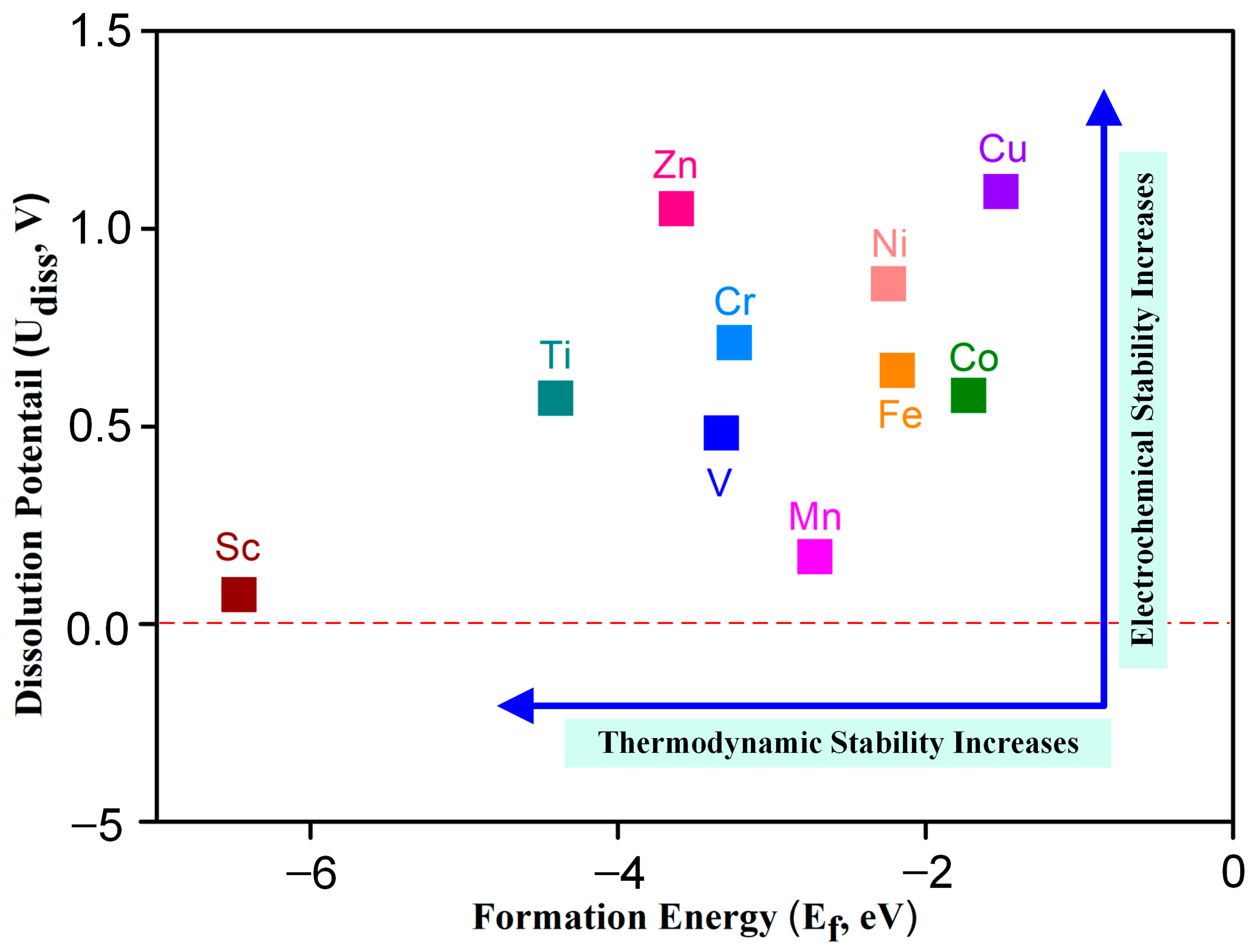

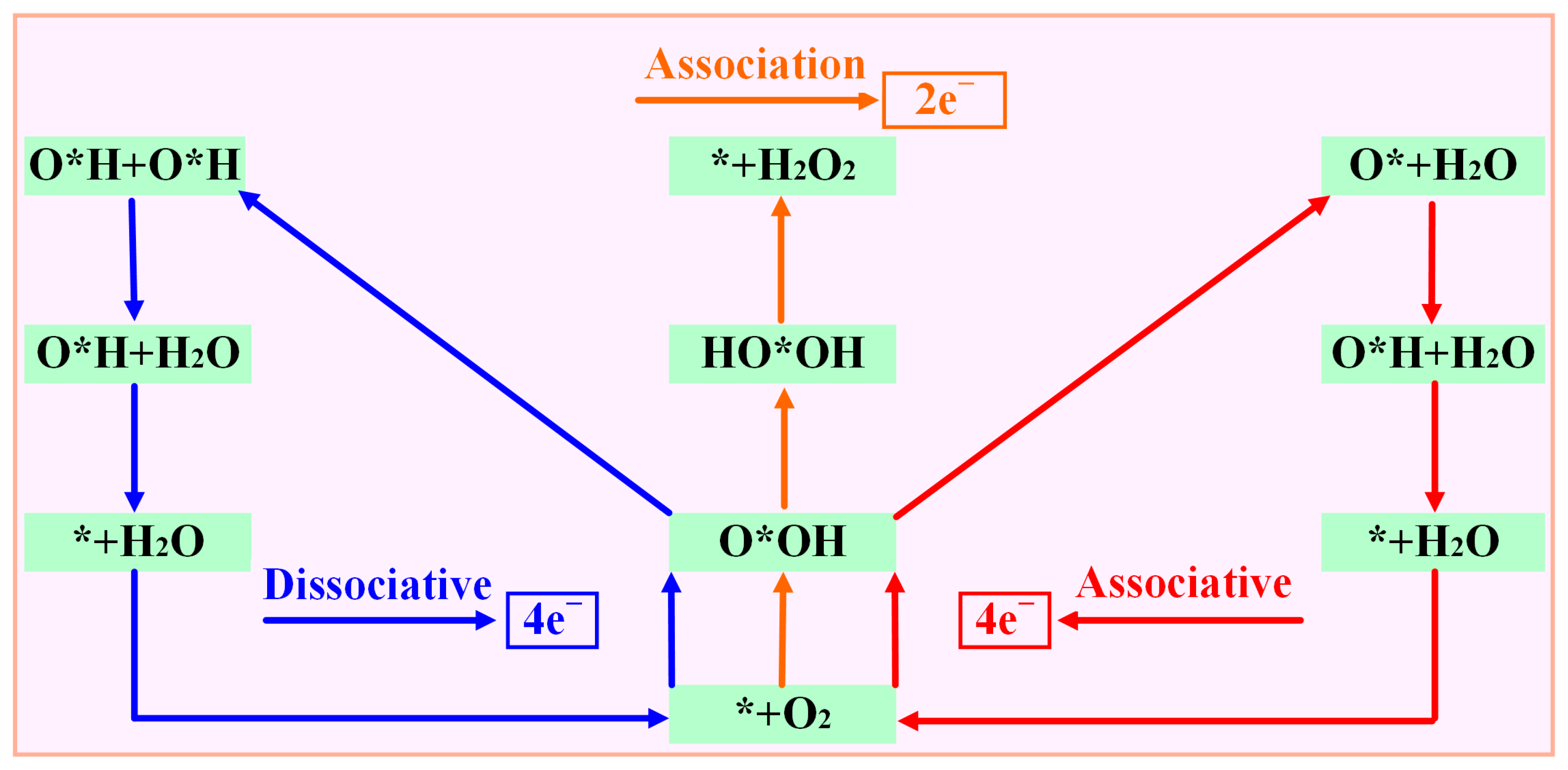
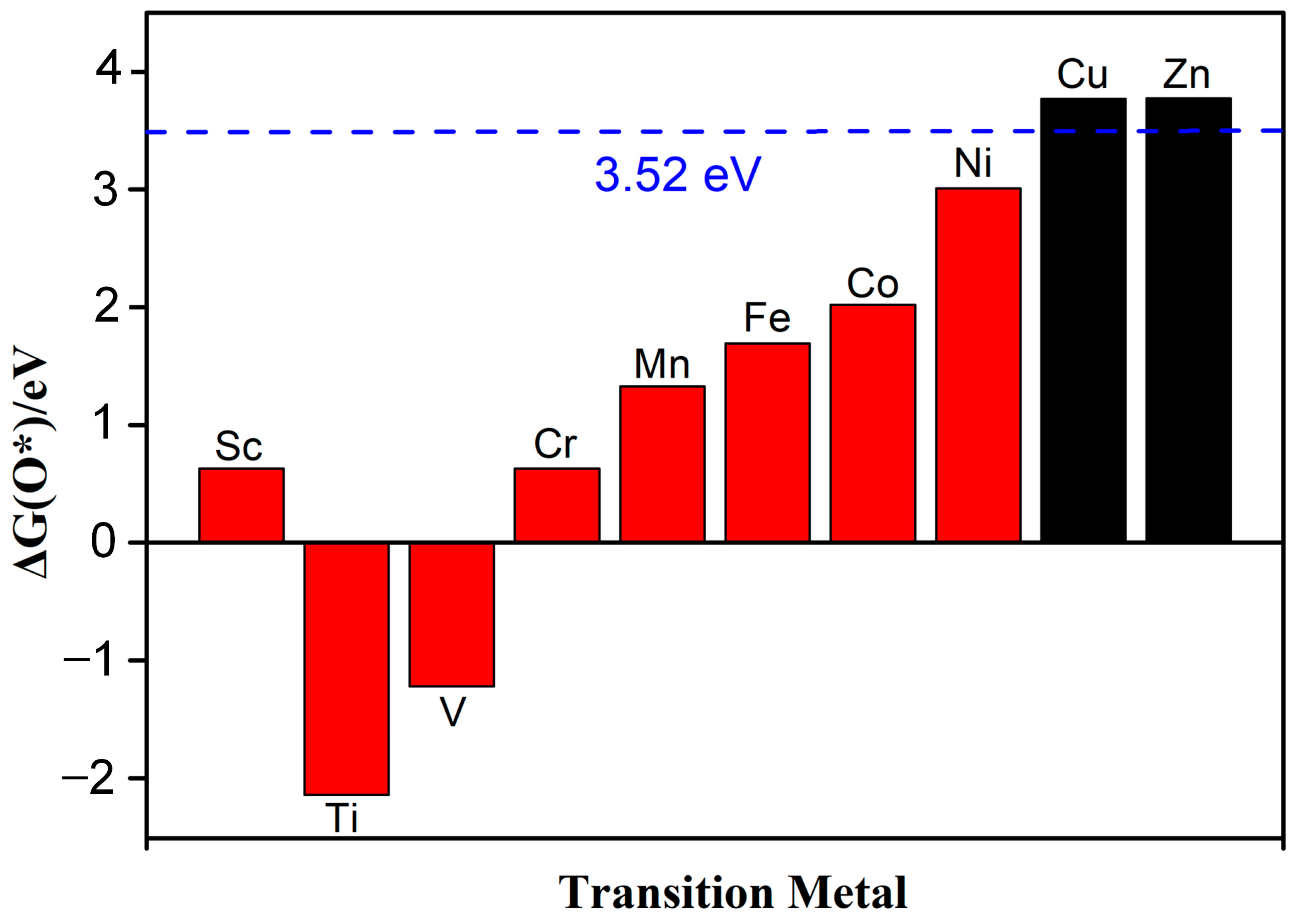

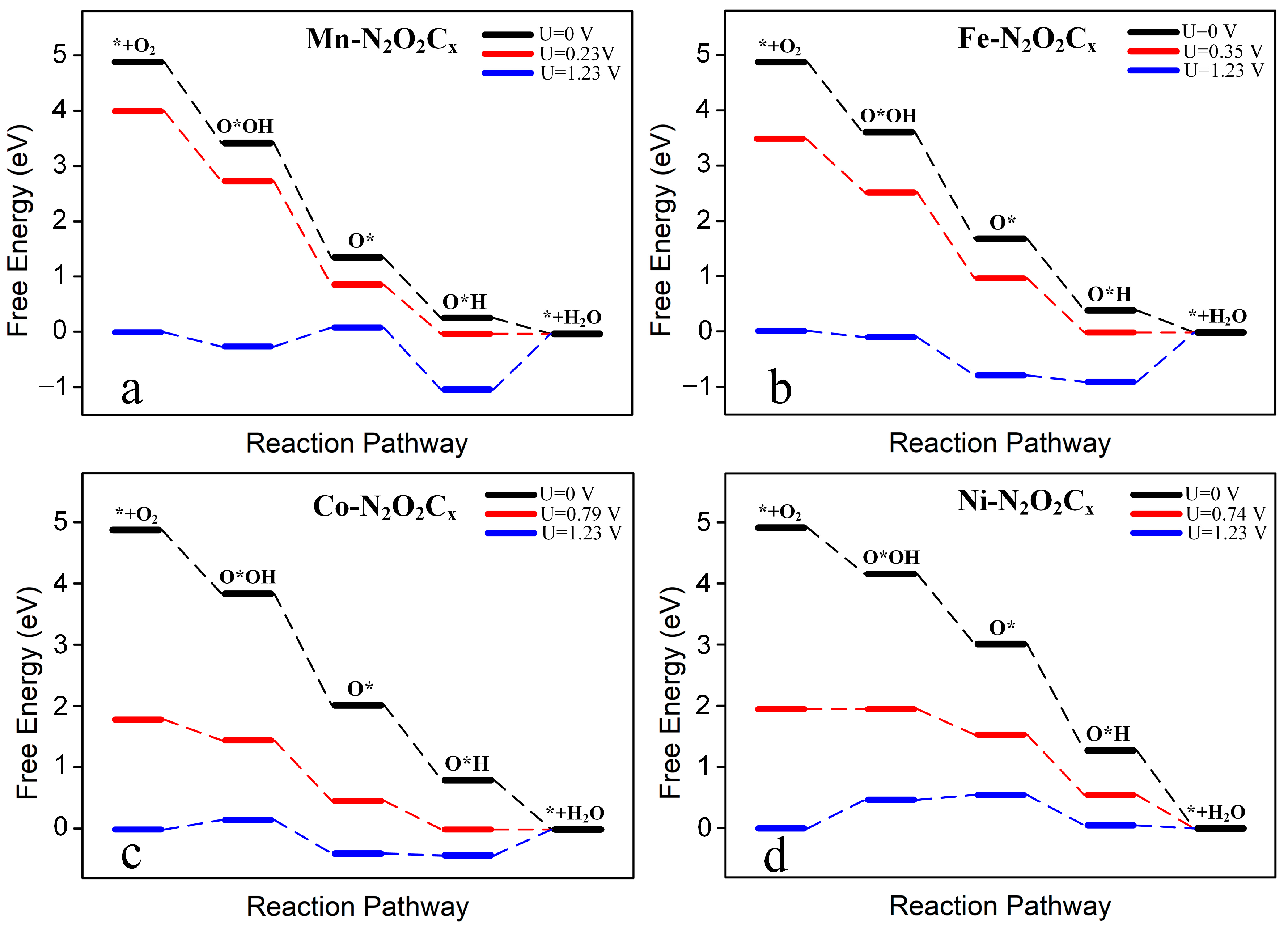
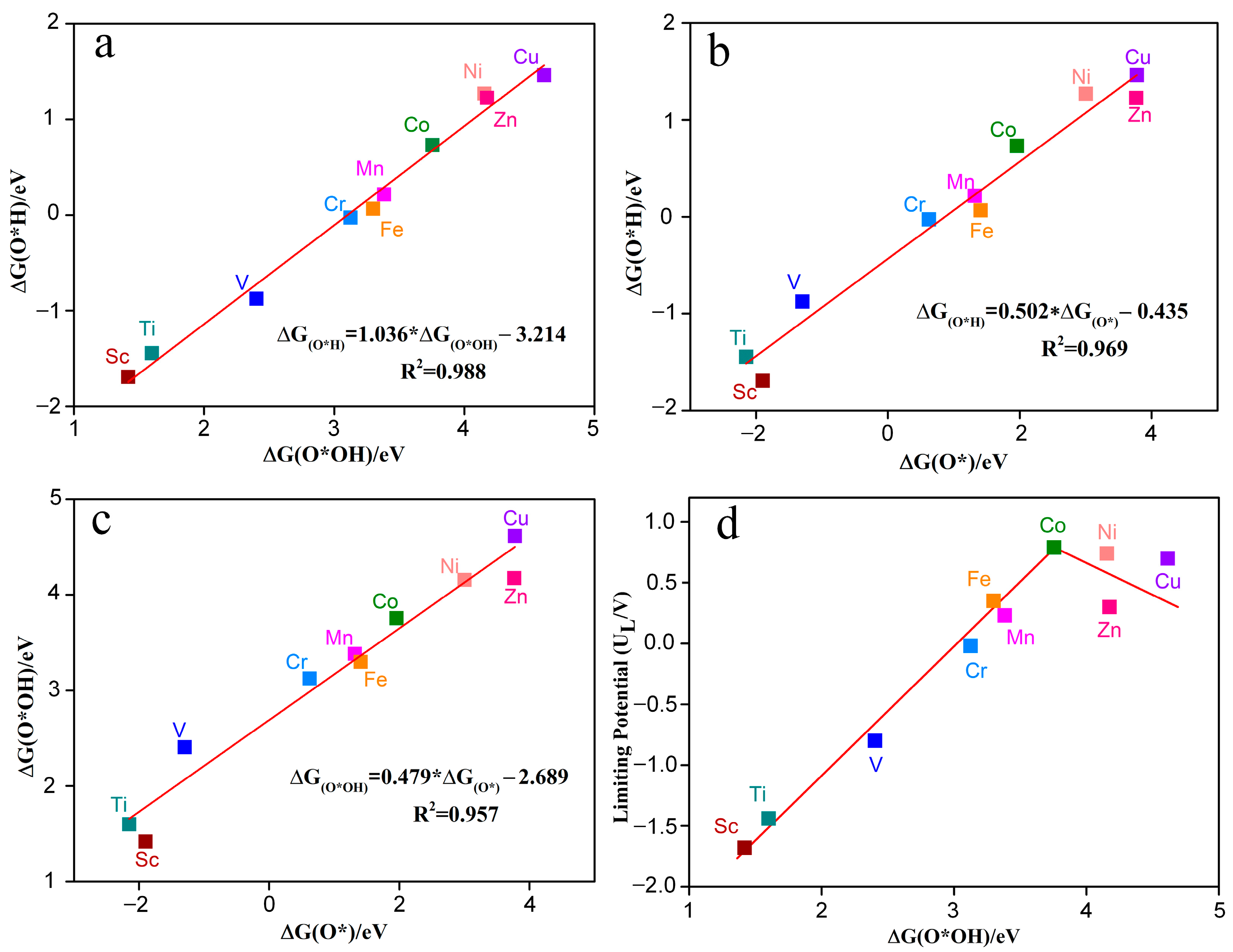
| TM-N2O2Cx | PDS | UL | ƞ |
|---|---|---|---|
| Sc-N2O2Cx | *OH → * + H2O | −1.68 | 2.91 |
| Ti-N2O2Cx | *OH → * + H2O | −1.44 | 2.67 |
| V-N2O2Cx | *OH → * + H2O | −0.80 | 2.03 |
| Cr-N2O2Cx | *OH → * + H2O | −0.02 | 1.25 |
| Mn-N2O2Cx | *OH → * + H2O | 0.23 | 1.00 |
| Fe-N2O2Cx | *OH → * + H2O | 0.35 | 0.88 |
| Co-N2O2Cx | *OH → * + H2O | 0.79 | 0.44 |
| Ni-N2O2Cx | * + O2 → O*OH | 0.74 | 0.49 |
| Cu-N2O2Cx | * + O2 → O*OH | 0.70 | 0.53 |
| Zn-N2O2Cx | O*OH→ *+H2O2 | 0.30 | 0.93 |
Disclaimer/Publisher’s Note: The statements, opinions and data contained in all publications are solely those of the individual author(s) and contributor(s) and not of MDPI and/or the editor(s). MDPI and/or the editor(s) disclaim responsibility for any injury to people or property resulting from any ideas, methods, instructions or products referred to in the content. |
© 2023 by the authors. Licensee MDPI, Basel, Switzerland. This article is an open access article distributed under the terms and conditions of the Creative Commons Attribution (CC BY) license (https://creativecommons.org/licenses/by/4.0/).
Share and Cite
Liu, J.-H.; Jiang, H.; Liao, B.; Cao, X.; Yu, L.; Chen, X. Construction of Single-Atom Catalysts for N, O Synergistic Coordination and Application to Electrocatalytic O2 Reduction. Molecules 2023, 28, 7264. https://doi.org/10.3390/molecules28217264
Liu J-H, Jiang H, Liao B, Cao X, Yu L, Chen X. Construction of Single-Atom Catalysts for N, O Synergistic Coordination and Application to Electrocatalytic O2 Reduction. Molecules. 2023; 28(21):7264. https://doi.org/10.3390/molecules28217264
Chicago/Turabian StyleLiu, Jin-Hang, Huixiong Jiang, Bokai Liao, Xiaohua Cao, Langhua Yu, and Xiudong Chen. 2023. "Construction of Single-Atom Catalysts for N, O Synergistic Coordination and Application to Electrocatalytic O2 Reduction" Molecules 28, no. 21: 7264. https://doi.org/10.3390/molecules28217264
APA StyleLiu, J.-H., Jiang, H., Liao, B., Cao, X., Yu, L., & Chen, X. (2023). Construction of Single-Atom Catalysts for N, O Synergistic Coordination and Application to Electrocatalytic O2 Reduction. Molecules, 28(21), 7264. https://doi.org/10.3390/molecules28217264









